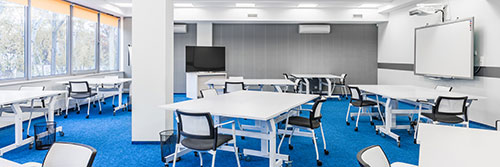
A great majority of educational researchers’ time and energy is devoted to pinpointing the most effective methods of teaching and learning, with priority being given to the latter. In turn, it is of no surprise that researchers have devoted, and continue to devote, time and energy to identifying aspects of the physical environment of classrooms that enhance effective teaching and learning. The problem, however, is that those in the field of education (i.e. teachers, administrators, school boards, school building designers) often are not aware of how aspects of a school’s physical environment affect student learning. Following this line of thinking, the purpose of this research post is (1) to identify the factors of the physical environment that have been shown via educational research to influence classroom learning (either negatively or positively) and (2) to identify what findings regarding the physical environment’s effect on learning would be useful to teachers, administrators, school boards and school designers. Once these factors and findings are identified, they can be examined more deeply to determine which should be prioritized for the greatest effect on student learning. Recommendations for such prioritization are provided based on the conclusions of this research.
Factors that Influence Classroom Learning
A comprehensive review of the available educational literature and research identified the following physical factors that influence classroom learning: Air quality, temperature, technology, lighting, noise, ceilings, displays, color, furniture, and desk arrangement.
 Where school air quality is concerned common sense and educational research agree that poor air quality results in decreased health of the student population, which logically leads to other issues (such as absenteeism due to sickness)(Woolner et al., 2007; Earthman, 2004). In order for students to operate at peak performance they must be healthy, and clean air is paramount to that. In turn, a well maintained ventilation system is seen as key to a healthy school (Khattar, 2003; Kimmel, 2000). School building designers and the school district boards they serve need to understand the importance of clean air and a high quality, well maintained ventilation system in school buildings. The design and funding of a proper ventilation system lies with these two parties.
Where school air quality is concerned common sense and educational research agree that poor air quality results in decreased health of the student population, which logically leads to other issues (such as absenteeism due to sickness)(Woolner et al., 2007; Earthman, 2004). In order for students to operate at peak performance they must be healthy, and clean air is paramount to that. In turn, a well maintained ventilation system is seen as key to a healthy school (Khattar, 2003; Kimmel, 2000). School building designers and the school district boards they serve need to understand the importance of clean air and a high quality, well maintained ventilation system in school buildings. The design and funding of a proper ventilation system lies with these two parties.
While it is generally agreed that a warm environment is most comfortable for most individuals in classroom settings (Burke & Burke-Samide, 2004), it is unclear what exact temperature (i.e., a specific Fahrenheit or Celsius reading) is best for optimal classroom learning. The issue is that each students have their own ideal temperatures and Burke & Burke-Samide (2004) point out that classroom temperatures deviating only slightly from a student’s preference can affect student learning negatively.
Knowledge of the ideal temperature for classroom learning would best benefit district school boards and their administrations, as the standard building temperatures are often set and maintained by the central district administration offices. Building administrators would make best use of this information by making immediate requests for adjustments to building and room temperatures when necessary. In scenarios where building administrators and teachers have the ability to control individual room temperatures, the value of this information would clearly increase for those individuals.
Although technology may not be typically be viewed as a factor of a classroom’s physical environment, Lippman’s (2010) research recommends it be seen otherwise. While technology has become an integral part of students’ everyday lives, and has become as important to student learning as other factors of the physical environment (e.g., seating arrangements), classrooms have not been modified accordingly. In fact, Lippman’s assertion, which is supported by Weiss (2007), is that technology is often integrated into the modern classroom without considering underlying pedagogy. An example of this has been district installations of Smart boards in all classrooms without consideration of how specific teachers of specific courses will utilize the boards according to their pedagogical backgrounds. Though the improper integration of technology in the classroom may not directly negatively affect student learning, it certainly does not improve student learning and misuses district funds in the process. The highly positive effects of an appropriately technology-integrated classroom, however, are detailed in Brooks’ (2010) study that resulted in the technology-integrated classroom’s biology education students outperforming their traditional classroom counterparts (Brooks, 2010). Information regarding the design of classrooms that properly integrate technology is useful to several groups within the education system. School designers, who often design the classrooms themselves, would be wise to understand the ideal design for a technology-based classroom if a school district board and its technology department decide to invest in technology integrated classrooms. District and building administrators would make use of this information for the purposes of scheduling and other decisions in which specific courses and teachers would be assigned to the classrooms equipped with technology. District technology departments in this scenario would also make use of such knowledge to understand how to support technology driven classrooms once the designers have moved on. This would be a key element in supporting the teachers, who—although they should be trained on how to effectively use the classrooms—would no doubt benefit from expert support.
Are you enjoying Part 1 of this series? If so, we encourage you to keep reading in [Part 2].
Part 1 References:
Earthman, G. I. (2004) Prioritization of 31 criteria for school building adequacy.
